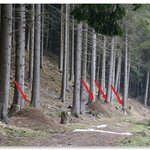Geology

The Qinling-Dabie orogenic complex, part of a large east-west mountain range in the heart of China, plays a key role in helping scientists understand the formation and breakup of the supercontinent Rodinia, according to a new paper.
Rodinia (Russian for "homeland") was Earth's first supercontinent. It hails from around 1.1 billion years ago and was formed when three or four existing continents collided in a large mountain-building episode called the Grenville Orogeny. There are also earlier hypothesized supercontinents, including a tiny one that is only considered a…

The end of the Atlantic Ocean is coming.
A new subduction zone forming off the coast of Portugal shows that a passive margin in the Atlantic ocean is becoming active and Europe could to move closer to America, according to a paper in Geology.
Subduction zones, such as the one beginning near Iberia, are areas where one of the tectonic plates that cover the Earth's surface dives beneath another plate into the mantle, the layer just below the crust. The incipient subduction in the Iberian zone could signal the start of a new phase of the Wilson Cycle - where plate movements break up…

Water in the Earth's upper mantle and crust likely plays a less important role as a lubricant of plate tectonics than previously assumed, according to a paper presented by geoscientists present in the current issue of Nature (13/06/2013) after the examination of water in the mineral olivine.
Laboratory experiments over the past three decades have suggested the presence of water greatly weakens the mechanical strength of the mineral olivine, a key component of the Earth's upper mantle.
In the recent study, led by the Bayerisches Geoinstitut in Bayreuth, the Secondary Ion Mass Spectrometer (…

In the past 11,00 years, there have been 22 large and megathrust earthquake shaking events along the Pacific coast of North America, an average recurrence interval of about 500 years, though the time between major shaking events can stretch up to about 1,000 years, according to a new paper.
How do you plan for that kind of event? The only way to predict the frequency and intensity of the ground motion expected from large and giant "megathrust " earthquakes is to analyze the geologic record and a new paper in the Canadian Journal of Earth Sciences gives a well-dated first record of…

If Martians wanted to vacation some place exotic, they might pick the Redwood forests of the Pacific, yet if they wanted to feel like they were at home, but with better hotels, a researcher has determined the best analogue of Mars.
Australia.
Associate Professor Patrice F. Rey (University of Sydney) has recently outlined attributes suggesting that the Australian red center could be a close analogue for the surface of the red planet – and how this unusual weathering has led to the formation of Australia’s opals.
Precious opal, Australia’s national gemstone, has been mined from the red dirt of…

We all know that the Earth is in constant motion, rotating beneath our feet, but new research in Nature Geoscience
reveals that the center of the Earth is out of sync with the rest of the planet and is frequently speeding up and slowing down.
Associate Professor Hrvoje Tkalcic from the ANU College of Physical and Mathematical Sciences and his team used earthquake doublets to measure the rotation speed of Earth’s inner core over the last 50 years and discovered that not only did the inner core rotate at a different rate to the mantle – the layer between the core and the crust that makes up…
In a world of missing links and UFOs, bimonthly instances of the apocalypse and scientific scare journalism about chemicals and biology, Atlantis still reigns supreme as the thing most often discovered time and again. Since 360 B.C. everyone has wanted it to be real.
Really, when you had Plato creating your press releases that is to be expected. Who doesn't want to find a city of gold and Poseidon hanging around? The man knew how to turn a phrase.
Marine geologists working in the Rio Grande Elevation, in water 5,900 feet deep 1,800 miles from the Brazilian shore, say they have…

Water found on the moon and Earth came from small meteorites called carbonaceous chondrites in the first 100 million years or so after the solar system formed, according to researchers who found evidence in samples of moon dust returned by lunar crews of Apollo 15 and 17.
Comets did not deliver the molecules, they conclude in their Science Express article.
The discovery's telltale sign is found in the ratio of an isotopic form of hydrogen, deuterium, to standard hydrogen. The ratio in the Earth's water and in water from specks of volcanic glass trapped in crystals within moon dust match the…

A new study has identified hundreds of previously unrecognized small aftershocks after Utah's deadly Crandall Canyon mine collapse in 2007, which suggest that the collapse was perhaps bigger than previous estimates.
Six coal miners died in the Aug. 6, 2007 mine collapse, and three rescuers died 10 days later. The mine's owner initially blamed the collapse on an earthquake, but the University of Utah Seismograph Stations said it was the collapse itself, not an earthquake, that registered on seismometers.
A 2008 study by University of Utah seismologist Jim Pechmann found the epicenter of the…

Ants and Earthquakes
A recent paper linking red wood ant behaviour to earthquakes has been widely reported but not widely discussed. Such discussion and comment as there has been in the media has focused on the mechanism/s by which these ants might predict earthquakes. I believe that there is an important question to be addressed which may help explain the evolution of quake-detection mechanisms. Given that these ants seem to prefer to build their colonies along active faults, I suggest that the question to be addressed is: "why would any creature build its home on an active…